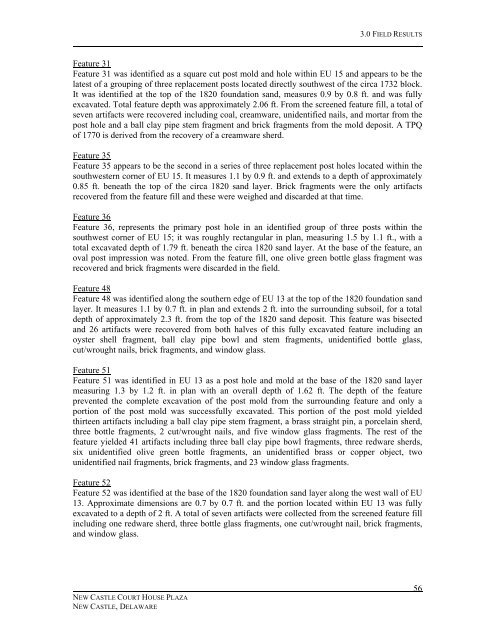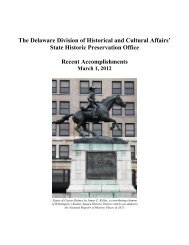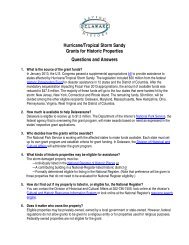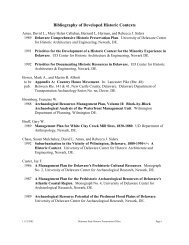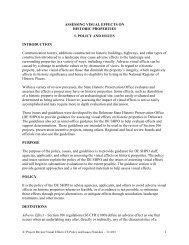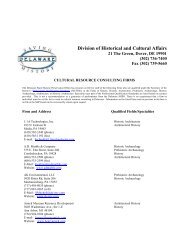Report of the Archaeological Investigations of the New Castle Court ...
Report of the Archaeological Investigations of the New Castle Court ...
Report of the Archaeological Investigations of the New Castle Court ...
Create successful ePaper yourself
Turn your PDF publications into a flip-book with our unique Google optimized e-Paper software.
NEW CASTLE COURT HOUSE PLAZA<br />
NEW CASTLE, DELAWARE<br />
3.0 FIELD RESULTS<br />
Feature 31<br />
Feature 31 was identified as a square cut post mold and hole within EU 15 and appears to be <strong>the</strong><br />
latest <strong>of</strong> a grouping <strong>of</strong> three replacement posts located directly southwest <strong>of</strong> <strong>the</strong> circa 1732 block.<br />
It was identified at <strong>the</strong> top <strong>of</strong> <strong>the</strong> 1820 foundation sand, measures 0.9 by 0.8 ft. and was fully<br />
excavated. Total feature depth was approximately 2.06 ft. From <strong>the</strong> screened feature fill, a total <strong>of</strong><br />
seven artifacts were recovered including coal, creamware, unidentified nails, and mortar from <strong>the</strong><br />
post hole and a ball clay pipe stem fragment and brick fragments from <strong>the</strong> mold deposit. A TPQ<br />
<strong>of</strong> 1770 is derived from <strong>the</strong> recovery <strong>of</strong> a creamware sherd.<br />
Feature 35<br />
Feature 35 appears to be <strong>the</strong> second in a series <strong>of</strong> three replacement post holes located within <strong>the</strong><br />
southwestern corner <strong>of</strong> EU 15. It measures 1.1 by 0.9 ft. and extends to a depth <strong>of</strong> approximately<br />
0.85 ft. beneath <strong>the</strong> top <strong>of</strong> <strong>the</strong> circa 1820 sand layer. Brick fragments were <strong>the</strong> only artifacts<br />
recovered from <strong>the</strong> feature fill and <strong>the</strong>se were weighed and discarded at that time.<br />
Feature 36<br />
Feature 36, represents <strong>the</strong> primary post hole in an identified group <strong>of</strong> three posts within <strong>the</strong><br />
southwest corner <strong>of</strong> EU 15; it was roughly rectangular in plan, measuring 1.5 by 1.1 ft., with a<br />
total excavated depth <strong>of</strong> 1.79 ft. beneath <strong>the</strong> circa 1820 sand layer. At <strong>the</strong> base <strong>of</strong> <strong>the</strong> feature, an<br />
oval post impression was noted. From <strong>the</strong> feature fill, one olive green bottle glass fragment was<br />
recovered and brick fragments were discarded in <strong>the</strong> field.<br />
Feature 48<br />
Feature 48 was identified along <strong>the</strong> sou<strong>the</strong>rn edge <strong>of</strong> EU 13 at <strong>the</strong> top <strong>of</strong> <strong>the</strong> 1820 foundation sand<br />
layer. It measures 1.1 by 0.7 ft. in plan and extends 2 ft. into <strong>the</strong> surrounding subsoil, for a total<br />
depth <strong>of</strong> approximately 2.3 ft. from <strong>the</strong> top <strong>of</strong> <strong>the</strong> 1820 sand deposit. This feature was bisected<br />
and 26 artifacts were recovered from both halves <strong>of</strong> this fully excavated feature including an<br />
oyster shell fragment, ball clay pipe bowl and stem fragments, unidentified bottle glass,<br />
cut/wrought nails, brick fragments, and window glass.<br />
Feature 51<br />
Feature 51 was identified in EU 13 as a post hole and mold at <strong>the</strong> base <strong>of</strong> <strong>the</strong> 1820 sand layer<br />
measuring 1.3 by 1.2 ft. in plan with an overall depth <strong>of</strong> 1.62 ft. The depth <strong>of</strong> <strong>the</strong> feature<br />
prevented <strong>the</strong> complete excavation <strong>of</strong> <strong>the</strong> post mold from <strong>the</strong> surrounding feature and only a<br />
portion <strong>of</strong> <strong>the</strong> post mold was successfully excavated. This portion <strong>of</strong> <strong>the</strong> post mold yielded<br />
thirteen artifacts including a ball clay pipe stem fragment, a brass straight pin, a porcelain sherd,<br />
three bottle fragments, 2 cut/wrought nails, and five window glass fragments. The rest <strong>of</strong> <strong>the</strong><br />
feature yielded 41 artifacts including three ball clay pipe bowl fragments, three redware sherds,<br />
six unidentified olive green bottle fragments, an unidentified brass or copper object, two<br />
unidentified nail fragments, brick fragments, and 23 window glass fragments.<br />
Feature 52<br />
Feature 52 was identified at <strong>the</strong> base <strong>of</strong> <strong>the</strong> 1820 foundation sand layer along <strong>the</strong> west wall <strong>of</strong> EU<br />
13. Approximate dimensions are 0.7 by 0.7 ft. and <strong>the</strong> portion located within EU 13 was fully<br />
excavated to a depth <strong>of</strong> 2 ft. A total <strong>of</strong> seven artifacts were collected from <strong>the</strong> screened feature fill<br />
including one redware sherd, three bottle glass fragments, one cut/wrought nail, brick fragments,<br />
and window glass.<br />
56


